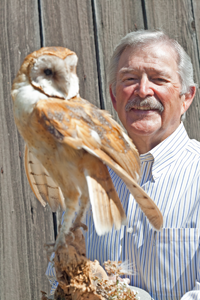Fred Vanderwold

Fred Vanderwold is the education specialist for the Cache Creek Conservancy, a member of the Board of Directors, and currently serves as the treasurer. In an interview, Vanderwold explains his role in the education programs run at the Cache Creek Nature Preserve. His experience with the children that he teaches gives insight into the educational value of the Cache Creek Nature Preserve.
Briefly could you describe where we are and what you see around you? And what the kids do here?
Well right now we’re down close to the actual Cache Creek; we’re in the riparian forest area of the creek. On the nature preserve we actually have examples of four different habitat types. We have the riparian corridor or forest, the oak woodlands, the grasslands and the wetlands We have a series of lessons that are age appropriate so the kids really learn and have an appreciation for the preserve. That’s what I’m all about, providing a safe place outdoors for kids to have fun and to learn. What makes it so important to me is when I see the kids: that discovery, that look in their face. Their eyes light up as “Ah ha! I saw something; I know something!” They have that feeling they know something that they didn’t know when they got here before. They ask questions. That’s another part of it. The questions are a big part of learning. Sometimes I answer the questions, but most of the time I let them answer the questions for themselves because we find something for them to work with. My passion for having youngsters outside is really because they just don’t have
the opportunity. They don’t always have a safe place where they can go and just create their own diversion, if you will, or play together. The only grass they happen to see probably is on the soccer field or on the baseball field. They don’t have an opportunity to go to vacant lots anymore and just dig a hole or roll in the grass.
Are there any favorite activities that you could maybe describe or favorite moments or stories?
I guess my favorite moment is down close to the creek when the kids get down here and maybe sometimes they don’t want to put on rubber boots. I hate to say it, but the high school students are the worst. They’re afraid if they take off their stylish tennis shoes and put on these boots they might look odd to somebody else, but they see others doing it and then they say, “Well I gotta do that too,” and so they’re right in there. So just getting out there and I guess when we plant things during the restoration projects, they get dirt under their fingernails. Some of them have never had dirt under their fingernails because they’ve never had a chance to dig a hole, you know. They never get a chance to put that plant in the ground because nobody has let them go to the community garden or something, but now we are planting natives, you know. Getting dirty is critical to becoming part of the experience.
How do you incorporate restoration into the education program?
For the little kids. restoration is not as big a part of my program as it is for the high school students. And so we encourage the participation by an organization called S.L.E.W.S., which is part of the Center for Land-BasedLearning. When those high school students come, we put together a program where they actually will plant a hedgerow or weed around plants. They learn how to set up irrigation systems. They learn what plants need to go in what kind of areas. That’s a big part of the restoration. The restoration is an ongoing thing and that’s one of the things we always talk about. We definitely include the idea that this land has been a variety of things over the years. I mean, it was a place to come and collect and to live, and then it became an area that was used by the agriculture industry. But then the gold of the area was actually the rock that was deposited. And so the aggregate part of the history of our place is still very important, very important because that’s where much of the money comes from to provide our outreach and education program. If it weren’t for the aggregate companies, who by the way are very environmentally conscious, this place wouldn’t exist.
It seems like a big part of the education here you’re allowed to touch things and you’re allowed to build things.
That’s exactly right. That’s all part of it. We want them to touch and feel everything. That’s why it [a model of Cache Creek] was designed so that they could walk all over it and they can’t hurt it. So, yeah, everything is to touch, to feel and to experience nature.
To download the audio, right click on the audio link above and scroll to "Save link as . . ." and choose the directory where you want to store the mp3. In Windows, you may have to use Control + S to select the link.